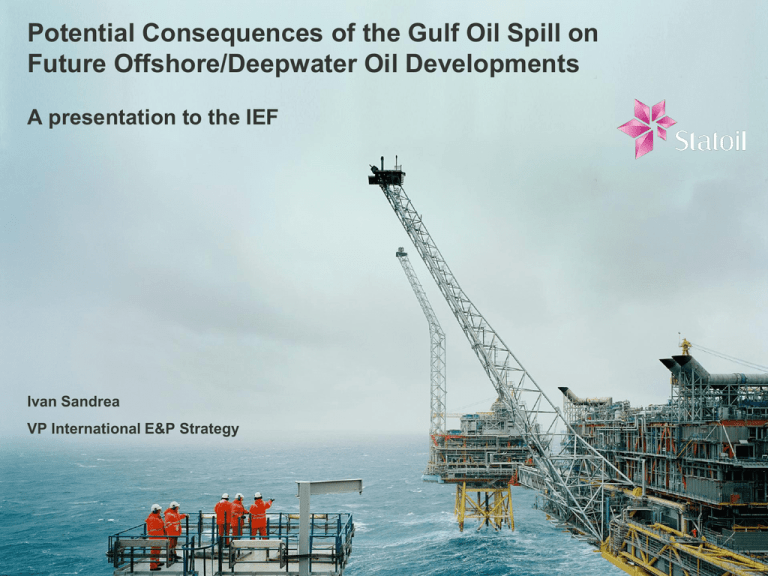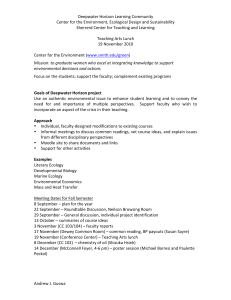
Potential Consequences of the Gulf Oil Spill on
Future Offshore/Deepwater Oil Developments
A presentation to the IEF
Ivan Sandrea
VP International E&P Strategy
Gulf oil accident
Source: Macondo Fire; Media
High impact industrial accidents in context
Bhopal, 1984
Chernobyl, 1986
Piper Alpha, 1988
Exxon Valdez, 1989
Pesticide plant in Bhopal, India
Nuclear Power Plant in Ukraine
North Sea oil production platform
Oil tanker, Alaska
• Toxic gases released into
the atmosphere
• ~20,000 deaths
• Nuclear reactor rupture led
to a series of explosions
• 56 deaths. Long term
impact on thousands
• Production platform
explosion
• 167 deaths
• Oil spill
• Severe damage to
environment (~200.000
seabirds died)
• Industries rushed to
improve safety
procedures
• UCC paid USD 470 mill. in
settlement
• CEO charged with
homicide
• Strong regulation changes
on the Nuclear industry
• Moratorium on
construction of new
nuclear facilities
• Plant/Process redesign
• Changes in responsibilities
& accountabilities
• Equipment modification &
standardization
• Creation of the Oil
Pollution Act
• Changes in regulation
• Equipment & process
modification
Source: Accenture
Copyright © 2010 Accenture. All Rights Reserved.
3
Gulf oil accident: new regulatory environment and
improved measures
MMS
The disaster was the last blow for the MMS which had
previously been embroiled in many scandals
• Including poor administration of the royalty system,
receipt of gifts and revolving door practices
Within 3 weeks of the disaster it was announced the
MMS would be restructured into 3 separate bodies:
Bureau of Ocean
Energy Management
• Controls leasing of
continental shelf for
energy resources
Bureau of Safety and
Office of Natural
Environ. Enforcement
Resources Revenue
• Supervises offshore
• Collects and manages
activities including safety
resource royalties and
& the environment
revenues
Announced operational
in December 2011
Announced operational
in December 2011
Source: BCG, MMS
Announced operational as
soon as October 2010
• New regulations in the US.
• Once a dominant jurisdiction;
i.e., U.S., institutes regulatory
change, other jurisdictions will
adopt. The Macondo incident
will beget new regulations,
procedures and standards.
• There will be extra regulations,
inspections and reporting
requirements
Introduction
Gulf oil accident: our industry is being challenged
in a number of areas and we will need to respond
Portfolio
Partnering
Technology and R&D
• Is there adequate assessment of risk/reward trade-offs in the
asset portfolio and how will portfolio composition be decided?
• What will drive the approach to partnering?
• Do we have the required technology and is our R&D adequate?
Operating Model
• Is the way we organise and manage our business fit for
purpose?
Operational Risk
Management
• Do all the elements needed to effectively manage operational
risk at the asset level work in sync?
Stakeholder
Engagement
• Is our approach to communication and engagement good
enough to maintain our licence to operate and (re)build trust?
Source: Accenture
Contents
• Long term historical perspective
• Deepwater: how we got here?
• Status of world oil production
• Potential consequences
How important is the offshore?
Most giant discoveries are being made offshore
250
100%
Number of giant discoveries
90%
200
80%
Onshore
70%
Offshore
150
% onshore
60%
% offshore
50%
100
40%
30%
50
20%
10%
0
0%
1900
1910
1920
1930
1940
1950
Source: Horn and Mann, 2006; giant discoveries > 500 mboe
1960
1970
1980
1990
2000
How important is deepwater?
40 to 60% of new reserves in the last 2 decades
Opening of deepwater world wide
100%
90%
80%
70%
60%
50%
40%
30%
20%
10%
Water depth > 200 meters
Onshore and Shallow er Water
Source: IHS; Bernstein; Cumulative discoveries in water depth > 200 meters totals 180 bn
boe of 2P reserves; discoveries in water depth of > 500 m totals 133 bn boe
Decade Average
2009
2007
2005
2003
2001
1999
1997
1995
1993
1991
1989
1987
1985
1983
1981
1979
1977
1975
1973
1971
1969
1967
0%
1965
Onshore v Deepwater Global Discoveries
Share of global discoveries (bn boe)
Mainly Brazil and GoM
How important is deepwater?
Another source of oil supply, contributor to growth
100%
Share of world oil production
90%
80%
70%
60%
50%
Deepwater
40%
Offshore
Onshore
30%
20%
10%
0%
1950
1955
1960
1965
1970
1975
Source: Sandrea, 2010; IHS; Deepwater water depth > 500m
1980
1985
1990
1995
2000
2005
How important is deepwater?
Another source of oil supply, contributor to growth
Source: Sandrea, 2010
World oil – non OPEC supply system (status)
Offshore/deepwater close to 50% of production
Tar Sands, EHO, SO, OS
(Growing)
DW
(Growing)
1.3
5
Shallow offshore growing everywhere
except in shallow
GoM, Mexico, NS,
Maracaibo, parts of
Asia, Egypt
22.5
15
5.2
NGLs
(Growing)
Units: mbpd; Excludes biofuels and Processing gains; includes Angola and Ecuador
Onshore - mostly
mature/stable in OECD,
Russia S, China NE, ME
but immature in C Africa,
Parts of Caspian, Russia
E, China W, parts of
LATAM
World oil – OPEC supply system (status)
Offshore/deepwater rising share of OPEC oil
NGLs
(Growing)
Orinoco?
0.6
WA Offshore / DW
(Growing)
4.9
2.5
16
MENA Offshore
(more expansions)
5.5
2.4
3.6
Iraq?
Onshore Other
(Mature/declining)
Units: mbpd; Excludes biofuels and Processing gains; excludes Angola and Ecuador
Onshore Other includes Venezuela Lake Maracaibo; MENA: Middle East North Africa
MENA Onshore mature/stable
but new major
expansions still
taking place
Deepwater producers
Brazil
US GoM
Angola
Nigeria
India
Egypt
Norway
Equatorial Guinea
Malaysia
Congo
Israel
Philippines
Australia
UK
Indonesia
Cote d`Ivoire
Mauritania
-
Production, kboepd
500
1,000
1,500
2,000
Source: WM, 2010 production; Water depth > 500m; Oil and gas but share of gas is 17%; pie from
PFC
2,500
• Deepwater: how we got here?
How we got here?
Exploration water depth records broken every “decade”
4000
Mainly Brazil and GoM
Opening of deepwater world wide
3500
Water Depth (m)
3000
2500
experiments
2000
1500
1000
500
1965
1970
1975
Source: Statoil; WM; Water depth > 500 m
1980
1985
1990
1995
2000
2005
2010
How we got here?
310
352
243
Drilling of ~200 wells per year, ~$30 bn pa
Brazil E
Brazil A
898
GoM E
795
Number of wells
GoM A
RoW E
RoW A
680
Exploration: >2000 wells
Each IOC has drilled ~500 wells,
60% in Water depth > 1000 m
Source: WM; Statoil; Water depth > 500 m
Deepwater discoveries (bn boe)
How we got here? Discoveries by major players
Source: IHS; Bernstein; share of deepwater discoveries; water depth > 500m
How we got here?
Progressive development of production technology
World Production from Deep (> 500 metres) Offshore Oilfields - mid 2010
7,000
Year of Production
Water depth Records
6,000
Thousand Barrels Oil Equivalent Per Day
2002
2010
Approx. average days to
first production from
discovery in offshore:
GoM: 2000 days
1999
Brazil 3000 days
Nigeria 4000 days
5,000
Angola 4900 days
4,000
3,000
Production includes
gas in an oilfield
1991 (Marlim)
2,000
Source: Statoil
(with permission)
1,000
1975
0
500
1,000
1,500
2,000
2,500
Water Depth (metres)
Source: CGES, Statoil; Water depth > 500m; Days to first production from DB data using all offshore
discoveries in last 40 years in over 300m of water depth
3,000
How we got here? – world largest oil spills
Limited environmental impact from direct offshore-drilling related accidents
US marine blow outs
Offshore (DW) accidents since 1990
Spills: 18 (4)
Rig explosion/fire: 14 (2)
Collisions: 8
Rig collapse: 5
Blow outs: 3 (1)
Source: NOAA; NAS; EPRINC spills with more 1 mm bbls; inset chart US largest Marine blow outs;
excludes spills that have not been properly reported/accounted for such as in Nigeria, Lake
Maracaibo, Sumatra, Ecuador; Statoil
How we got here? High-impact deepwater events
Sinking of the deepwater P-36 production - Brazil
2,500
2,000
1,500
1,000
500
19
96
19
97
19
98
19
99
20
00
20
01
20
02
20
03
20
04
20
05
20
06
20
07
20
08
20
09
20
10
Total Production ('000 boe/d)
Accident
• No specific
recommendations
made
• Investigation in
Petrobras
concluded that it
was a platform
design/construction
failure
• Limited impact on
Brazil production,
no environmental
impact
• World offshore
production kept
growing
P 36 was in 815 m of water. Semi sub (world largest); 180 kbpd; 268,000t, a storage capacity of 1.8
million bbl
• Thinking about the potential consequences of the Gulf oil spill
Industry migrating to resource plays, a new cost structure and
level of complexity. Deepwater remains important but
increasingly small share…How will this change?
Source: Nomura 2010
% of Total Remaining Reserves (mmboe)
Uneconomic deepwater oil reserves. How will this
change?
32
11.5
13.7
10.7
Brazil
Angola
USGoM
Nigeria
100%
90%
80%
70%
60%
50%
40%
30%
20%
10%
0%
Producing
Undeveloped (Economic)
Under Development
Undeveloped (Uneconomic)
Source: Internal analysis, WM; excludes much of Brazil Pre Sal due to uncertainties
Global deepwater positions. How will this change?
Source: WM, water depth > 400 meters
Deepwater discoveries by water depth (ft)
Deeper, and ultra deepwater. How will this change?
Risk
Source: World Oil; IHS; DB; Bernstein; size of bubble represents size of discovery
Oil discoveries
in water depth >
1500 meters: 33
bn boe
Oil discoveries
in water depth <
1500 meters: 46
bn boe
Dealing with future offshore/deepwater oil spills. How
will this change?
Source: NOAA
• Potential consequences, offshore oil production outlooks
Offshore oil production outlooks
Table 1 Offshore Crude Oil Production Capacity Outlooks through 2030
EUR, Bbo:
Shallow
Water
320
Total Offshore
400
Year
2008
2010
2015
2025
2030
450
Deepwater
500
80
130
180
Production Capacity, million b/d
19.2
18.1
14.2
7.3
4.5
Source: Sandrea 2010; O&G Journal
23.3
23.6
20.5
12.4
8.8
24.4
16.2
12.2
27.4
20.0
15.6
4.1
5.5
6.3
5.1
4.3
10.2
8.9
7.7
13.2
12.7
11.1
World deepwater supply outlook
14
12
Million barrels per day
WM (2010) inc all
CERA
10
Wood Mackenzie
(excl. volumes
from prospects
and YTF)
8
DW, Sandrea
(2010)
WM (2004)
inc all
6
Big 4, Sandrea
(2001, 2004)
4
DW, Sandrea
(2010)
DW, Sandrea
DW, Sandrea
(2010)
(2009)
DW, Sandrea
(2010)
DW, Sandrea
(2010)
Big 4, Sandrea
(2004)
2
0
1990
1995
2000
2005
2010
2015
2020
2025
2030
Thank you
Ivan Sandrea
www.statoil.com



